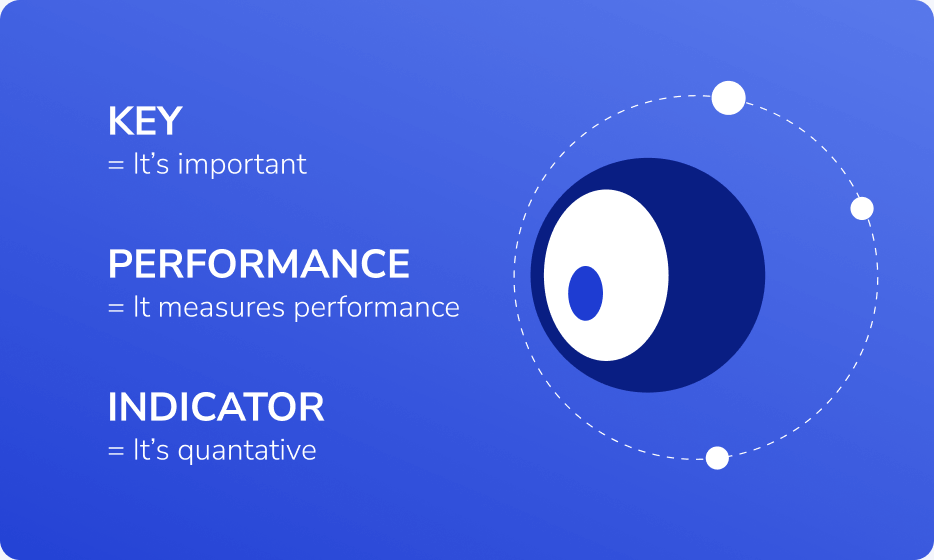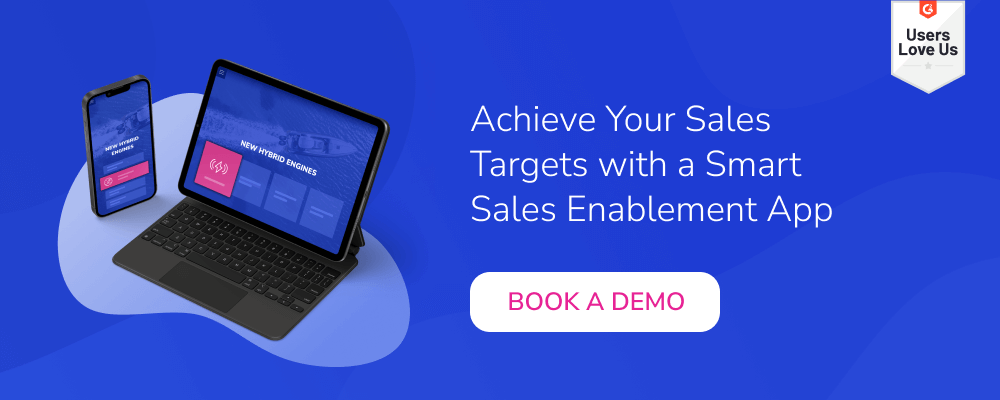Setting your sales team up for success requires more than advanced tools or trendy tactics. It starts with a clear strategy and well-defined sales enablement goals that include all teams involved in the process.
By focusing on strategic clarity, you can improve productivity across departments, prioritize high-value activities, and align efforts toward meaningful outcomes.
This is where SMART (Specific, Measurable, Achievable, Relevant, Time-bound) sales enablement goals come in. SMART goals eliminate ambiguity, offering a clear roadmap for everyone in the sales process.
This guide will walk you through how to create and implement SMART sales enablement goals to boost performance and help your organization hit its targets.
What are SMART Sales Enablement Goals?
Setting sales enablement goals is an essential component of sales success, but the effectiveness of goal-setting is significantly enhanced when you employ SMART criteria. The real impact in sales enablement comes from setting goals that are not just goals, but SMART goals.
According to a study by Drs. Edwin Locke and Gary Latham, two leading researchers in goal-setting theory, setting specific and challenging goals can enhance performance by up to 30% compared to vague or easy goals.
By implementing SMART criteria in your sales enablement goal-setting, you provide your team with clear, direct targets. SMART sales enablement goals provide a roadmap:
- Specific: Define clear objectives to focus efforts. By being specific about what needs to be achieved, teams can direct their efforts more effectively.
- Measurable: Track progress with tangible metrics. Measurable goals enable tracking of progress over time. This not only allows for strategic adjustments but also serves as a motivational tool, as team members can see the direct impact of their efforts.
- Achievable: Ensure goals are realistic to maintain motivation. Attainable goals ensure that targets are realistic and achievable given the available resources and market conditions, which is crucial for maintaining team morale and motivation.
- Relevant: Align goals with broader business objectives. Relevant goals align with the broader objectives of the business, ensuring that team efforts contribute meaningfully to the company's overall direction and success.
- Time-bound: Set deadlines to create urgency. Time-bound goals assist in task prioritization. A deadline, like achieving a sales target by the end of the quarter, helps maintain focus and a steady pace.
Why Use SMART Criteria When Setting Sales Enablement Goals?
Clarity and alignment are essential for cohesive sales operations. SMART criteria ensure all teams—from sales and marketing to product development and customer support—work toward unified objectives.
SMART sales enablement goals help each team understand their role while connecting their efforts to the organization’s broader targets. This approach fosters a synchronized, efficient sales process.
For example, instead of "Improve lead generation," a SMART goal might be, "Increase sales-qualified leads by 10% within the next quarter using account-based marketing and targeted outreach." This ensures clarity, measurability, and alignment.
Step-by-Step Guide For Setting SMART Sales Enablement Goals
The following steps will provide a clear pathway for you to set SMART sales enablement goals to achieve your sales enablement targets.
Step 1: Identify Specific Sales Enablement Objectives
The journey to effective SMART sales enablement goals begins with a deep dive into your team's current performance, challenges, and potential opportunities.
Start by analyzing your team’s performance to pinpoint challenges and opportunities. Collaborate with team members and other departments to uncover areas for improvement.
👉 Here's an example: If your team struggles with converting leads, a specific sales enablement objective might be to improve sales presentations or enhance product knowledge. This can be achieved through focused sales training sessions, where team members can practice their skills via role-playing scenarios or test their understanding with product quizzes.
|
👍 Achieving your sales enablement goals requires a skilled cross-functional team that can align with business objectives and successfully adopts sales enablement practices across the company. Learn more about 7 Essential Skills Your Team Needs to Achieve Sales Enablement Goals |
Step 2: Establish Measurable Metrics
Once you have identified specific sales enablement objectives, the next step is to establish measurable metrics that enable you and your team to track progress and determine the success of your initiatives.
Incorporating measurable metrics into your sales enablement goals ensures that you can evaluate the effectiveness of your sales enablement, strategies and make data-driven decisions for improvement. Additionally, having clear, quantifiable indicators motivates your team by providing a concrete way to measure their achievements and progress.
To establish measurable metrics, first, define the key performance indicators (KPIs) that align with your objectives. These KPIs may include metrics such as the number of leads generated, the conversion rate from lead to customer, or the average deal size.
Make sure that these metrics are easily trackable and accessible to your team, using tools like CRM systems or sales enablement software.
Let’s explore some specific, measurable, relevant, and time-bound examples of sales enablement goals:
👍 Product knowledge: A measurable goal for improving product knowledge might be to increase the average score on quarterly product knowledge assessments by 15% within six months.
👍 Lead generation: If your objective is to boost lead generation, a measurable goal could be to increase the number of sales-qualified leads by 10% over the next quarter.
👍 Sales conversion rate: To enhance the conversion rate, you might set a goal of increasing the percentage of leads that convert into customers from 10% to 12,5 % within six months.
👍 Sales cycle length: If you aim to shorten the sales cycle, an example measurable goal could be to reduce the average sales cycle length from 90 days to 80 days in the next six months.
👍 Upselling and cross-selling: To improve your team's ability to upsell and cross-sell, set a goal to increase the average revenue per customer by 15% within the next two quarters.

Step 3: Ensure Achievable and Realistic Sales Enablement Goals
Setting achievable and realistic sales enablement goals creates a supportive environment that encourages your sales team to strive for excellence and fosters a culture of continuous improvement. On the other hand, setting goals that are challenging yet achievable can boost morale, as your team sees their efforts leading to tangible results and growth.
Setting goals that are challenging yet achievable can boost morale, as your team sees their efforts leading to tangible results and growth
To determine whether a goal is achievable, consider your team's current performance, available resources, and the timeframe for completion. It's essential to strike a balance between setting ambitious objectives that inspire your team to push their limits and ensuring that the goals are realistic given the current circumstances.
You can use historical data, industry benchmarks, and input from your team members to assess the attainability of your goals. Additionally, consider breaking larger goals into smaller, manageable milestones, making it easier for your team to track their progress and celebrate small wins along the way.
👉 For example, if your team’s current conversion rate is 10%, aim to increase it by 10% within six months with additional training and resources.
Step 4: Define Time-bound Parameters
Defining time-bound parameters instills a sense of urgency and maintains focus for your teams. You motivate them to prioritize their efforts and remain committed to making progress within the specified deadlines.
It also enables you to effectively monitor your team's progress and make necessary adjustments to your strategies if results are not being achieved within the expected timeframes.
To define time-bound parameters, first, determine the appropriate timeframes for achieving your sales enablement objectives.
Consider factors such as the complexity of the goal, the resources available, and the urgency of the desired outcome. Timeframes can range from short-term goals, like increasing the number of sales calls by 10% within a month, to long-term goals, like expanding into a new market within a year.
👉 For example, your team's ability to close deals has been underperforming, and you identify a need for additional sales and product training. Here’s your time-bound goal: Increase the sales team's closing ratio by 10% within the six months, following a series of weekly sales training workshops.
Once you have established the time-bound parameters, communicate them clearly to your team and ensure they understand the importance of meeting these time-specific targets. Regularly review your team's progress toward these goals and provide feedback, support, and guidance to keep them on track.
Monitoring and Adjusting Your Sales Enablement Goals
Monitoring and adjusting your sales enablement goals is a critical part of the goal-setting process. Regular monitoring provides opportunities to refine your strategies and celebrate achievements, which can boost morale and motivate your team to continue striving towards their objectives.
It’s key to use the measurable metrics you established in step two. Regularly review these metrics to assess your team's progress toward their goals. If you find that progress is slower than expected, or if new challenges arise, don't hesitate to adjust your goals or strategies as needed.
This might involve extending the deadline, providing additional resources, or revising the goal to better fit the current circumstances.
Remember, the ultimate aim is to support your team in improving their sales capabilities and achieving the broader business objectives. Regularly communicate with your team about their progress, addressing any concerns and celebrating successes along the way. By actively monitoring and adjusting your sales enablement goals, you can ensure that your team stays on track and continuously moves towards your objectives.

In summary...
Navigating the ever-evolving sales enablement landscape requires a leader and team that's not only skilled but also strategically equipped with SMART goals.
Setting these Specific, Measurable, Achievable, Relevant, and Time-bound goals is the compass that guides your team's efforts, a yardstick to measure their progress, and the roadmap that directs them toward impactful activities. These goals are your catalyst for turning a good sales team into a great one.
But the journey doesn't end with setting SMART goals. Remember, these goals are your guiding light, but you're the one holding the torch. So, keep shining the light on opportunities, empowering your team with clear goals, and driving them toward exceptional sales performance.
Ready to transform your sales team with SMART goals? Click the banner below to book a demo with us!
Learn next:

Curious how to start?
Discover how you can leverage sales enablement in your guided selling approach.
Book a demo today!




